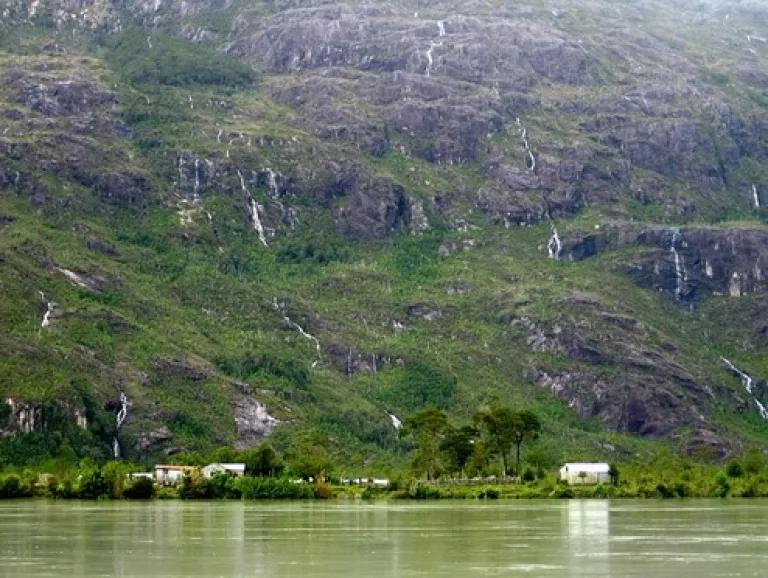
When I say that this part of Chile is remote, I truly mean remote.
During the full four days of our trip down the Baker River, we saw maybe ten homes along the banks, and three of them were abandoned. We visited four of them for various reasons: to ask permission to walk through their property so Brian could take water samples, to inquire if they had a CB radio (internet, land-line phones or cellular service were not even mentioned), or merely to get off the boat and stretch our legs. Regardless of our purpose, all of the people we met were welcoming, generous and kind.
the first house we passed during our trip
The visit that stands out most in my memory was the hour we spent with a mother and son, Julia and José, on the last, longest and wettest day of the trip. We had been on the Baker for two hours, rowing through a steady, endless rain. The map alluded to a “little town” nearby, where we decided to stop for a rest. This “little town” was actually a group of five small wooden buildings, all seemingly abandoned. The mist, the silence and the lush green grass created a landscape that was both eerie and beautiful.
After roaming for a bit, we found a house that looked inhabited. (The barking dogs outside were a dead give-away.) A few minutes later, a man opened the door and tentatively walked outside into the rain. The first thing he did was apologize for taking so long to meet us. “We were sleeping,” he said. Of course! We left camp at seven am, so it was only just after nine.
Despite their abrupt awakening by four drenched, shivering strangers, José and his mother Julia urged us to come inside and immediately loaded the central stove with firewood so we could warm ourselves and dry off. For the next hour we drank mate (tea) and talked with them about a range of topics. Julia has lived there her entire life—she was born in 1939—and her family has always made their living in the logging industry, specifically harvesting local cypress trees. We asked them what they thought of HidroAysén’s dams (“maybe good, maybe bad, we’ll see”), how long they’ve had their solar panel outside (“almost 15 years–and it still works. It powers our radio—more important than the lights”), their family (“some of them live nearby, but many have moved to the bigger towns”) and of course, the weather (“I don’t ever remember such a rainy summer. Something’s just not right”).
The stove, the mate and the company all warmed us up quickly, yet we were hesitant to leave. And José and Julia were hesitant to let us go, making us promise to visit again the next time we pass by. We talked about them for the rest of the day, all of us impressed by their warmth and hospitality.

...and the last house we passed
Another encounter literally walked out of the forest, and also left a big impression on me.
Brian Reid has made this trip on the Baker eleven times now, and he said that apart from the locals living in the houses along the river, he has never come across another person there. Which is why we were all surprised one morning when a group of four people approached us: a man and woman, their 10-year old daughter, and their guide. They were riding on the horse trails above and saw us packing up the boat, preparing to get on the Baker. They were curious and friendly, and thrilled to see foreigners visiting Patagonia.
This family was from Santiago and was traveling in the region for three weeks because the parents wanted their daughter, “to know Chile. To really know our country and its nature. We think that is important.” The girl was shy, but clearly enjoying the trip. When I told them that I work for NRDC and explained what we do, the mother said, “wonderful. But you must have a lot of hard work to do here!” We talked a little while longer before pushing off, and they all waved at us from the shore until we went around the first bend and were out of sight.
***
Although I never learned their names and our conversation lasted less than ten minutes, the comment the parents made about the reason for their vacation struck me as really meaningful. And it stays with me still. I’ve spoken with people in Santiago who expressed surprise when I told them that Patagonia is in Chile (“Really? I thought it was only in Argentina!”). And an “outdoorsy” culture is still fairly nascent in most parts of the country. So this 10-year old girl represents a new generation – a generation that will be aware of Chile’s remarkable natural resources and appreciate them in a way many people now do not.
The girl’s mother was right about something else: our work is wonderful. And hard. And we have a lot of it to do. Yet every person I met during those four days on the Baker River inspired me anew to do this work, to protect this Patagonia, and to save what beauty we can for the next generation—like that girl—to enjoy.

